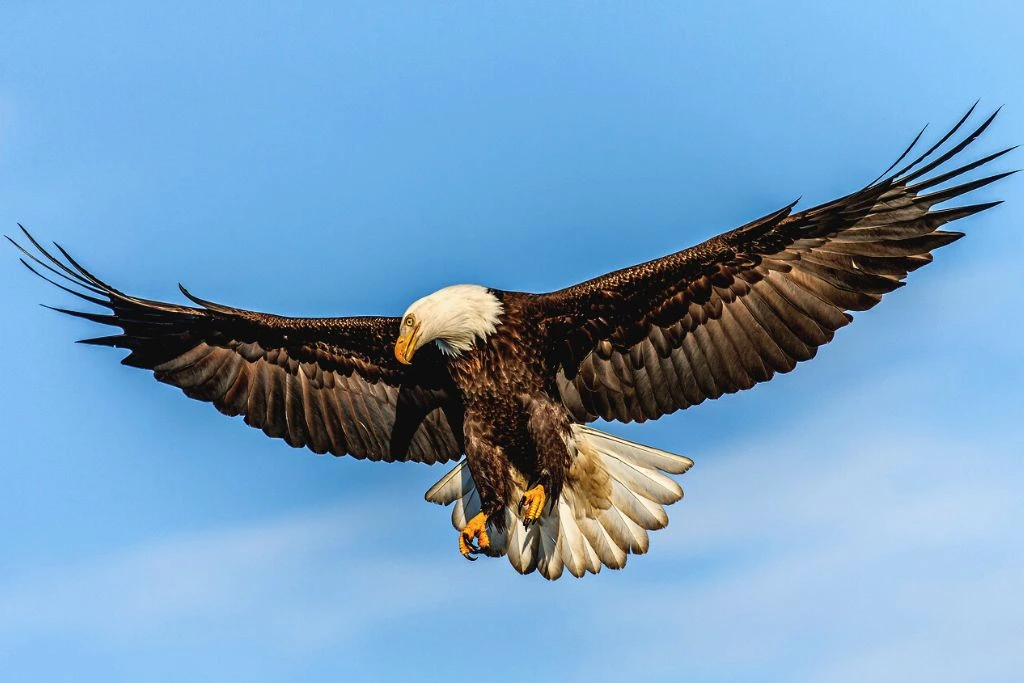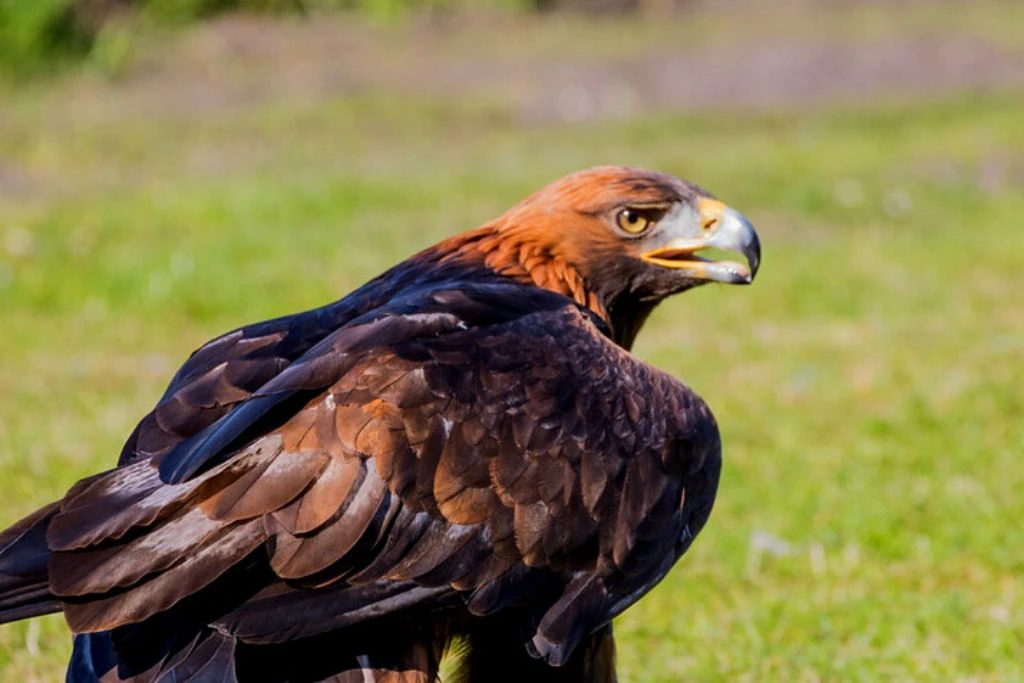Nowhere in the country better captures this fusion of coastal breeze, arid deserts, and lush woods than the Golden State, located on the United States’ western border. Tall redwoods and secluded mountains in California provide the perfect habitat for relatively uncommon birds, like eagles, to dwell in peace, especially now that protected areas have made it illegal to endanger them.
Given their size and strength, eagles are sometimes referred to as the “lord of the skies.” They have a close bond with people on both a mental and physical level.
These magnificent birds represent many things, including independence, courage, integrity, inspiration, victory, and pride. Few eagle species live in California, unlike other raptors. Only a small number of species can be seen across the entire continent.
What Kinds of Eagles Can Be Found in California?
Two types of eagles can be seen in California. These are the Golden Eagle and the Bald Eagle.
1. Bald Eagle

- Kingdom: Animalia
- Phylum: Chordata
- Class: Aves
- Order: Accipitriformes
- Genus: Haliaeetus
- Species: Haliaeetus leucocephalus
- Length: 34-43 in (86-109 cm)
- Weight: 168 oz (4761 g)
- Wingspan: 72-96 in (183-244 cm)
In California, you may see bald eagles all year long. Up to 2% of bird watchers’ checklists for the state’s summer and winter seasons include them.
The bald eagle is a well-known predatory bird. It has a huge, hooked yellow bill, a white head, and yellow eyes. It has a chocolate brown body and enormous yellow legs with paws.
Except for being roughly 25% larger, females resemble males in appearance. Bald eagles typically breed in Canada before migrating to the US for the winter. However, some live there year-round, particularly in coastal areas. Wetland habitats are where you can see Bald eagles during their breeding season.
2. Golden Eagle

- Kingdom: Animalia
- Phylum: Chordata
- Class: Aves
- Order: Accipitriformes
- Genus: Aquila
- Species: Aquila chrysaetos
- Length: 27 – 38 in (69 – 97 cm)
- Weight: 160 oz (4534 g)
- Wingspan: 72 – 96 in (183 – 244 cm)
In California, golden eagles can be seen all year long, but from October to April, the winter months are when they are most numerous. 1% of bird watchers’ winter checklists include them.
Although adults resemble one another, females are bigger than males. Similar to adults, juveniles have a deeper tint that can occasionally appear black on the back.
Golden eagles that hatch in Canada and Alaska travel south to the United States and Northern Mexico to spend the winter. Golden eagles, however, remain all year long in Western US states. Golden eagles inhabit hilly areas well above the treeline. When nesting, they also live in canyons, cliffs along rivers, and bluffs.
Subspecies of Golden Eagle
The golden eagle has six living subspecies, each of which varies significantly in size and color. Individuals of each subspecies vary somewhat, and there are clear distinctions between them, particularly in terms of physical size.
Aside from these traits, there is little variety in the species’ range. They are found all over the world.
1. Iberian Golden Eagle (Aquila Chrysaetos Homeyeri)
Since it has feathers across its legs, the Iberian golden eagle belongs to the Accipitridae family of barefoot eagles and is a huge bird of prey. One of the most prevalent eagles in the Northern Hemisphere is the golden eagle, which is a subspecies. It is an accipiter and a raptor.
The Iberian golden eagle has red-golden-brown, or pale rusty, feathers just on its neck and is dark brown. In contrast to Europe, the Iberian golden eagle is widespread throughout the Iberian Peninsula. Additionally, it is observed in countries in Northern Africa, the Caucasus–primarily Turkey–and Central Asia. It favors both forested areas and open meadows.
2. Asian Golden Eagle (Aquila Chrysaetos Daphanea)

One of the most prevalent and huge raptors is the Asian golden eagle. It goes by the name Berkut or Himalayan golden eagle. The rear of the neck of the Asian golden eagle is covered in red-golden-brown feathers.
It is common throughout Kazakhstan, Iran, and the Caucasus. Additionally, from Pakistan to Bhutan, it can be found in the Himalayan ranges. It favors both forested areas and open meadows. It can dive at 150 miles per hour (240 km per hour) to get its prey.
3. Japanese Golden Eagle (Aquila Chrysaetos Japonica)

The Japanese golden eagle is a huge raptor with a wingspan of 200 centimeters (80 inches or more) or more and is a member of the eagle family. The Japanese golden eagle is a classic raptor with a pointed beak and piercing eyes. Its body is covered with dark brown feathers, and the species gets its name from the characteristic golden wash that covers the back of its head and neck.
The Japanese golden eagle uses sticks and twigs from Japanese cypress, oak, and maple trees to construct its nest on cliff margins in mountainous terrain. It lives in the mountainous regions of Hokkaido and Honshu, including the Shirakami Mountains, a World Heritage site that lies on the boundary of the prefectures of Aomori and Akita.
4. European Golden Eagle (Aquila Chrysaetos Chrysaetos)
The European golden eagle is the smallest and palest subspecies. The adult of this subspecies is reddish-golden-brown on the upper side, unlike golden eagles seen farther east in Eurasia. The feathers in the nape patch are extremely long and frequently shine golden.
Europe is home to the golden eagle’s nominate subspecies. They are mostly found in the British Isles (primarily in Scotland), most of Scandinavia, Southern and Northernmost France, Italy, and Austria in Europe. They also extend south into Western Kazakhstan and Northern Iran at a similar longitude.
5. North American Golden Eagle (Aquila Chrysaetos Canadensis)
On the back, the North American golden eagle is dark brown to blackish. Compared to the nominate subspecies, the long feathers at the nape and top of the neck are rusty-red, slightly narrower, and darker.
Except for Nova Scotia, the species can be seen sporadically reproducing across Canada. Breeding populations are currently nonexistent in the Eastern United States that runs from North Dakota to Westernmost Nebraska and Oklahoma to West Texas. It has the biggest breeding range of any subspecies and is most likely the most common.
6. Siberian Golden Eagle or Kamchatkan Golden Eagle (Aquila Chrysaetos Kamtschatica)
The Siberian golden eagle, also known as the Kamchatkan golden eagle subspecies, can be found in Western Siberia, most of Russia, the Altay (which extends into Northern Mongolia), the Kamchatka Peninsula, and the Anadyrsky District. Male wingspan averages between 24.3 to 27.8 in (61.8 and 70.5 cm), and female wingspan averages between 26 to 28 in (65 and 72 cm).
These eagles have practically the same coloring as those in the North American golden eagle. The key distinction is that this subspecies is considerably larger and is almost the same size as the Asian golden eagle if traveling at wing length.
Frequently Asked Questions
How Many Different Kinds of Eagles Can Be Found in California?
Two of North America’s four eagle species have been sighted in California–the bald and golden eagle.
How Many California Eagles Are Still Present?
In California, over 1,000 bald eagles have been observed during statewide surveys conducted in the middle of winter. On the California-Oregon border, the Klamath Basin is home to the greatest number of wintering eagles.
Do Golden Eagles Live in California?
The coastline range in the larger Bay Area has the world’s largest population of golden eagles. A few golden eagles reside at Los Vaqueros all year, while others only visit. The golden eagle is among North America’s largest, fastest, and most agile raptors.
What Are the Three Largest Eagles?
Haast’s Eagle
Wingspan: 2 to 3 meters
Weight Range: 15 kg
Location: New Zealand’s South Island
Steller’s Sea Eagle
Wingspan: 1.9 to 2.5 meters.
Weight Range: 4.9-6 kg (male) / 6.2-9.5 kg (female)
Location: Russia
White-Tailed Eagle
Wingspan: 2 to 2.4 meters
Weight Range: 3.5 to 7 kg
Location: Russia, Norway, and parts of Eurasia
What Is the Name of a Group of Eagles?
A “convocation” or a “soar” are two collective nouns for a group of eagles. These are highly subjective terms that vary from one country to another. When eagles congregate, they are known by various names, including settlers, jubilee, flock, or spread.
Conclusion
Certainly, both golden and bald eagles are sheltered in California, so even before populations have stabilized, they are no longer in danger.
It helps that eagles are permitted to flourish in locations like Alaska and Canada because many of these birds will migrate south during the coldest months of the year, finally settling in Northern California before continuing south toward Mexico.





